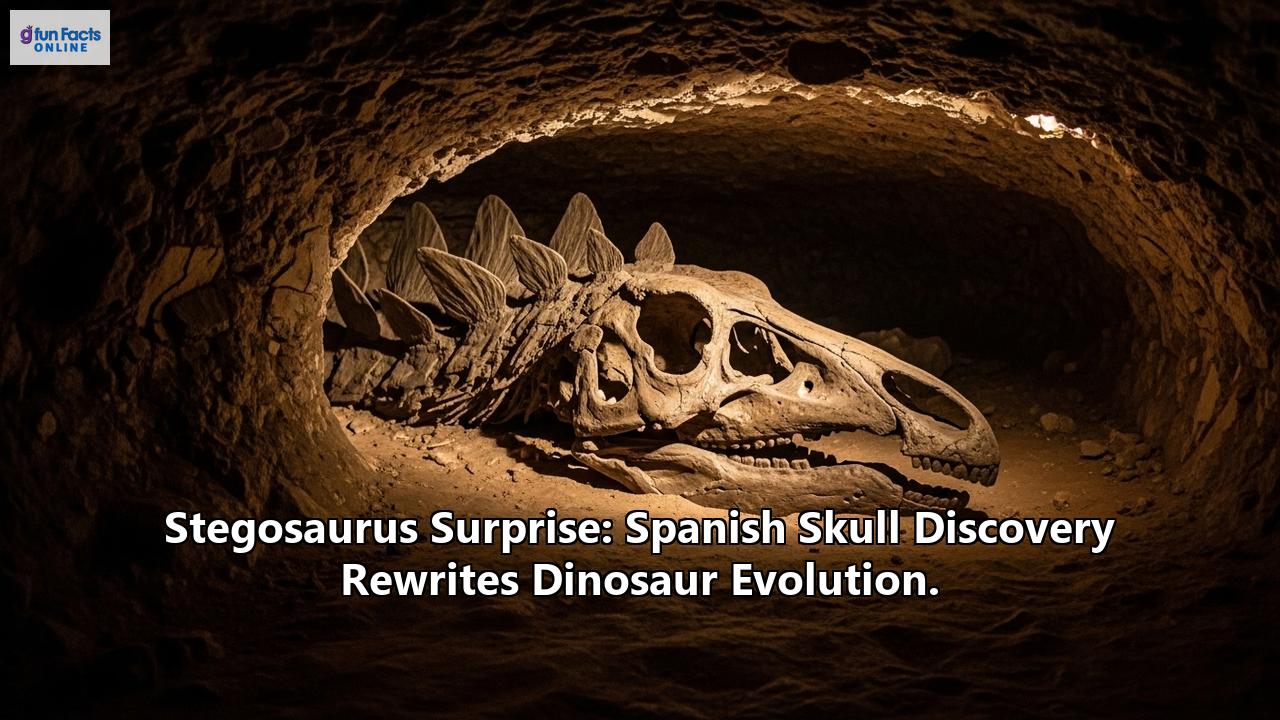In a thrilling development for palaeontology, the sun-baked hills of Riodeva in Teruel, Spain, have yielded a fossil that is dramatically reshaping our understanding of stegosaurian dinosaurs. A remarkably complete 150-million-year-old stegosaur skull, identified as belonging to the species Dacentrurus armatus, is not only the most complete of its kind ever found in Europe but has also prompted a significant revision of the evolutionary history of these iconic plated dinosaurs.
The exceptional fossil was unearthed by palaeontologists from the Fundación Conjunto Paleontológico de Teruel-Dinópolis at the "Están de Colón" fossil site. The rocks encasing this ancient treasure belong to the Villar del Arzobispo Formation, dating back to the Late Jurassic period, approximately 150 million years ago. Dinosaur skulls are a rare find due to the delicate nature of their bones, which often disintegrate long before fossilisation can occur. Stegosaur skulls are particularly elusive because their small heads were prone to separating from the body after death. This makes the Spanish discovery, which preserves crucial parts of the snout, upper jaw, and braincase, exceptionally significant.
Sergio Sánchez Fenollosa, a researcher at the Fundación Dinópolis and co-author of a study published in the journal Vertebrate Zoology, highlighted the importance of the find: “The detailed study of this exceptional fossil has allowed us to reveal previously unknown aspects of the anatomy of Dacentrurus armatus, the quintessential European stegosaur, which in 2025 marks 150 years since its first description. This discovery is key to understanding how stegosaurian skulls evolved.”
Dacentrurus armatus, first named nearly a century and a half ago, was previously known mostly from scattered bones and armour plates. The newly found skull provides invaluable insights into the anatomy of this European giant. For instance, early observations suggest a narrower beak and differently set cheek teeth compared to its more famous North American cousin, Stegosaurus, potentially indicating different dietary preferences and adaptations to distinct ecosystems. The skull also reveals attachment points for neck muscles that would have supported the dinosaur's characteristic plates and spines.Beyond shedding light on Dacentrurus armatus, the completeness of this skull has enabled researchers to undertake a new phylogenetic analysis, reassessing the evolutionary relationships among stegosaurs worldwide. This has led to a groundbreaking proposal: the formal definition of a new group called Neostegosauria. According to the researchers, Neostegosauria encompasses medium to large-sized stegosaurian species that inhabited what is now Africa and Europe during the Middle and Late Jurassic, North America during the Late Jurassic, and Asia during the Late Jurassic and Early Cretaceous. This reclassification challenges previous assumptions about the stegosaur family tree, which were often based on armour plates or limb bones rather than more phylogenetically informative skull traits.
The Iberian Peninsula, particularly regions like Teruel and Valencia, has emerged as a hotspot for stegosaur fossils in Europe. Discoveries in the Villar del Arzobispo Formation, for example, constitute one of the main sources of knowledge about these dinosaurs at the end of the Jurassic period in Europe. The area has yielded remains referred to Dacentrurus armatus, Stegosaurus sp., and Miragaia, a stegosaur known for its remarkably long neck, with at least seventeen vertebrae. The Portuguese Miragaia longicollum, for instance, possessed more neck vertebrae than most sauropods. The presence of such diverse stegosaurs highlights the important role these herbivores played in Late Jurassic coastal ecosystems.
The Están de Colón site in Riodeva is proving to be a continuing treasure trove. Excavations have not only produced the remarkable Dacentrurus armatus skull but also over 200 additional bones, representing at least two individuals—an adult and a juvenile. Finding mixed-age fossil assemblages like this is particularly rare for stegosaurs and offers a unique opportunity to study their growth stages and life history.
Alberto Cobos, managing director of the Fundación Dinópolis and co-author of the publication, emphasised the dual significance of the research: "This dual achievement – both the study of an exceptional fossil and the proposal of a new evolutionary hypothesis – positions this research as a global reference in stegosaurian studies." He further noted that the Riodeva site continues to be a subject of research and still holds numerous relevant fossils, including more postcranial elements from the same adult specimen.
The armoured dinosaurs, known as Thyreophora, first appeared in the Early Jurassic. This group, meaning "shield bearers," includes the plated stegosaurs and the heavily armoured ankylosaurs. Early thyreophorans were generally small and some were even bipedal, like Scutellosaurus. However, by the Middle and Late Jurassic, they had evolved into large, quadrupedal herbivores with complex defensive armour. The new Spanish skull helps to fill in crucial details about the evolution of these fascinating creatures, particularly within the Stegosauria clade.
Future research on the Riodeva skull will involve further CT scanning and digital reconstruction, allowing for 3D printing and virtual sharing with researchers globally. As more fossils are meticulously freed from the rock, they will provide additional data to test and refine the Neostegosauria hypothesis.
This stunning Spanish discovery is more than just another fossil find; it's a pivotal moment that allows palaeontologists to look with fresh eyes at the evolution of one of the most recognisable dinosaur groups. A 150-year-old European dinosaur is finally revealing its face, and in doing so, is rewriting a significant chapter in the grand story of life on Earth.
Reference:
- https://scitechdaily.com/150-million-year-old-stegosaurus-skull-rewrites-dinosaur-evolution/
- https://www.earth.com/news/most-complete-stegosaur-skull-ever-found-forces-rewrite-of-plated-dinosaur-history/
- https://www.sciencedaily.com/releases/2025/05/250528132111.htm
- https://indiandefencereview.com/most-complete-stegosaur-skull-found-spain/
- https://vertebrate-zoology.arphahub.com/article/146618
- https://www.discoverwildlife.com/prehistoric-life/dacentrurus-armatus-skull-spain
- https://www.mdpi.com/1424-2818/14/12/1047
- https://pt.wikipedia.org/wiki/Miragaia_longicollum
- http://prehistoricbeastoftheweek.blogspot.com/2017/12/miragaia-beast-of-week.html
- https://dinodata.de/animals/dinosaurs/pages_m/miragaia.php
- https://www.alvorada.pt/index.php/lourinha/1597-miragaia-e-o-modelo-de-dinossauro-unico-no-mundo-que-ja-pode-ser-visto-no-dino-marque-da-lourinha
- https://www.ebsco.com/research-starters/earth-and-atmospheric-sciences/thyreophora
- https://royalsocietypublishing.org/doi/10.1098/rsos.201676
- https://www.tandfonline.com/doi/full/10.1080/14772019.2023.2205433

